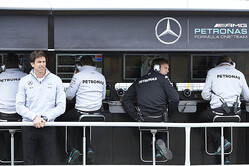


21/07/2016
NEWS STORY
 Whilst it is the radio communications between Mercedes and its drivers that grabbed the headlines in recent races, other incidents have put the controversial topic firmly in the spotlight.
Whilst it is the radio communications between Mercedes and its drivers that grabbed the headlines in recent races, other incidents have put the controversial topic firmly in the spotlight.
In Baku, Lewis Hamilton requested help from his team as he sought to correct his engine mode, the world champion left frustrated as he was advised that such help wasn't possible. Meanwhile, teammate Nico Rosberg, who was suffering a similar issue, was able to do without radio assistance claiming that he knew how to resolve the issue himself.
Fast forward to Silverstone and the German was guided by his team following a gearbox issue. Whilst notifying the driver of the problem was not against the rules, advising him how to get around it was, and it was for this that he received a post-race time-penalty thereby demoting him from second to third.
However, in Austria, paying strict heed to the radio communications regulations, which essentially only allow 30-odd different messages, Force India opted not to advise Sergio Perez of imminent brake failure, leaving the Mexican to crash heavily on the very last lap.
Much like the situation with track limits, with little consistency from the FIA and its stewards, teams are left to their own interpretation of the regulations.
Furthermore, with an eye on Rosberg's 10s penalty in Britain, rival teams may well gamble, feeling that a similar penalty is worth taking if it means assisting its drivers.
Now, ahead of this weekend's Hungarian Grand Prix, the FIA has acted, making a number of revisions to the rules.
Most importantly, the radio restrictions now only apply when the car is on track, whereas previously the rules applied the moment a car left its garage. Therefore, drivers can now dive into the pitlane where they will be free to communicate.
However, from this weekend, with a nod to Rosberg's situation at Silverstone, if a driver has a problem the team must include the instruction to pit for any necessary repairs, a move which will cost time and positions.
"Indication of a problem with the car, any message of this sort must include an irreversible instruction to enter the pits to rectify the problem or to retire the car," says the FIA directive.
Also, with Rosberg in mind, it is now the responsibility of the teams to demonstrate that any instructions to fix a critical issue does not enhance the car's performance.
"Instructions to select driver defaults, this must be for the sole purpose of mitigating loss of function of a sensor, actuator or controller whose degradation or failure was not detected and handled by the onboard software.
"It will be the responsibility of any team giving any such instruction to satisfy the FIA technical delegate that this was the case and that any new setting chosen in this way did not enhance the performance of the car beyond that prior to the loss of function."
Finally, the FIA has tightened up the teams' information stream in terms of damage to cars, the revised rules restricting them to advise only of damage to the bodywork as opposed to other components.
Check out our Thursday gallery, here.